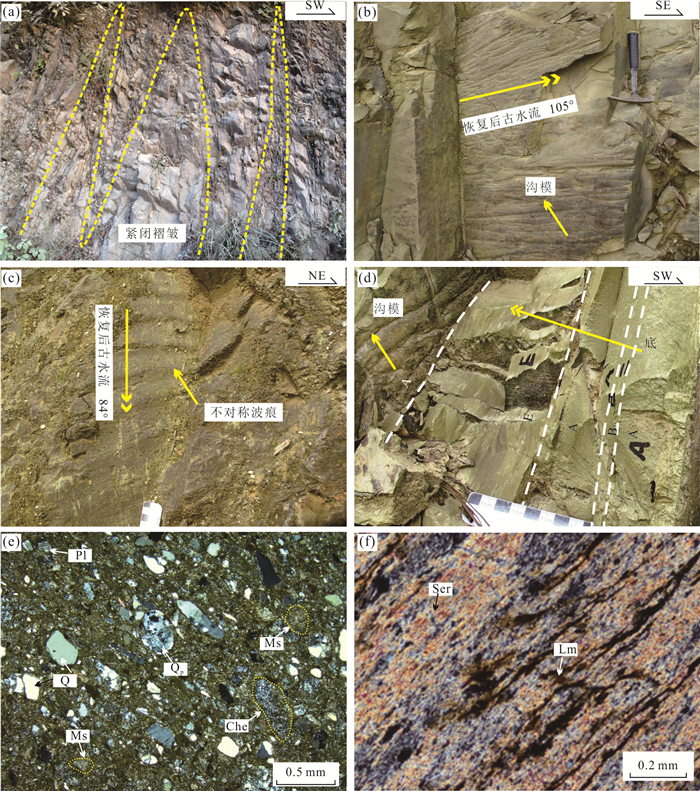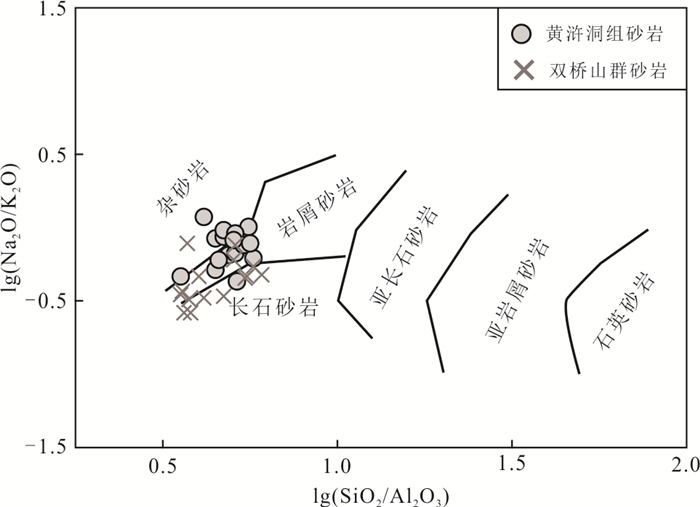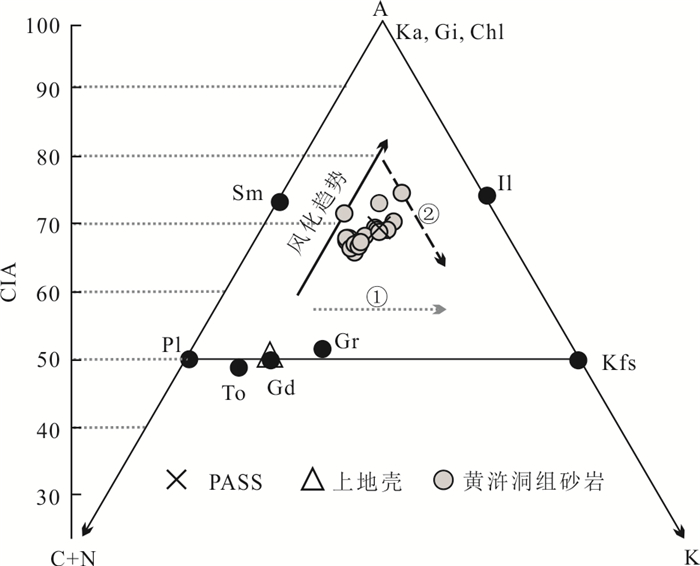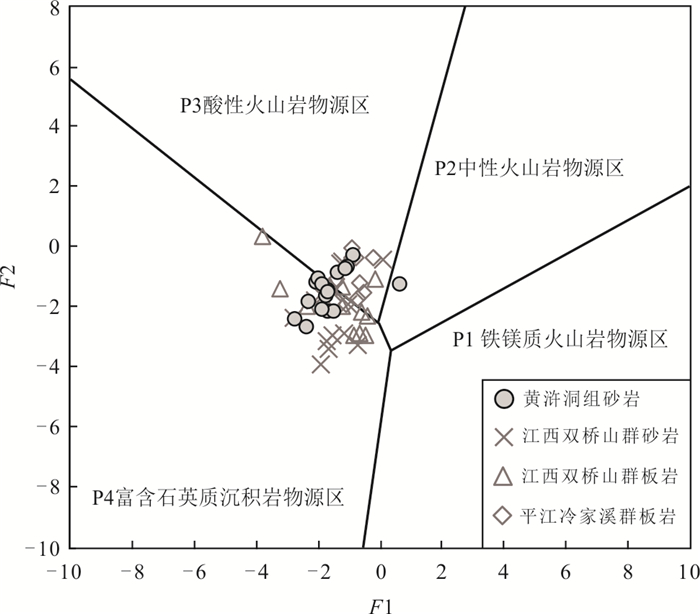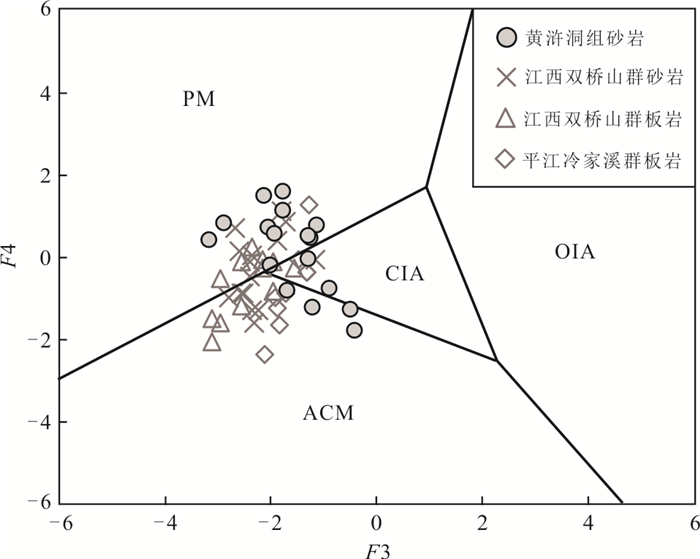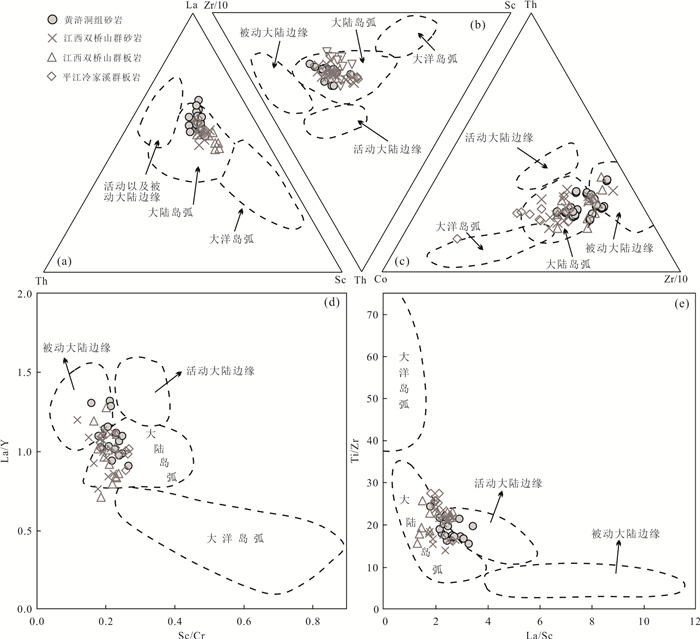Provenance and Tectonic Setting of Lengjiaxi Group in the Central Jiangnan Orogen: A Case Study of Huanghudong Formation, Yueyang Area
-
摘要: 为揭示江南造山带中段冷家溪群沉积物源与构造背景,选取湖南东北部岳阳地区黄浒洞组为研究对象,开展岩石学、沉积学、地球化学及锆石年代学研究工作.结果显示,黄浒洞组杂砂岩杂基含量高(常>25%),碎屑颗粒贫石英(25%~40%),富含长石(15%~25%)与岩屑(15%~30%),分选差,磨圆差-中等.全岩SiO2含量(63.39%~72.88%,平均70.14%)中等,(Fe2O3T+MgO)*(6.04%~8.29%,平均6.81%)与TiO2*(0.67%~0.92%,平均0.74%)含量较高,K2O/Na2O(0.84~2.35,平均1.43)比值高,Al2O3/SiO2(0.17~0.28,平均0.20)比值低,最接近形成于大陆岛弧环境杂砂岩的特征值.样品具有中等ICV值(平均0.86)与CIA值(70~80),指示物源包含再循环的古老沉积物与第1次循环物质,且源区经历了中等化学风化作用.杂砂岩样品稀土元素含量较高(ΣREE平均173.02×10-6),具有与上地壳及PAAS相似的球粒陨石标准化配分型式,呈现轻稀土富集((La/Yb)N平均7.32)、重稀土平坦、中度Eu负异常(Eu/Eu*0.58~0.70,平均0.66)特征,但与上地壳相比,明显富集重稀土((La/Yb)ucc平均0.70).1件凝灰岩夹层样品的锆石LA-ICP-MS U-Pb年龄为824 ±3.1 Ma,指示黄浒洞组沉积于新元古代.结合前人研究成果,黄浒洞组杂砂岩低的结构与成分成熟度,北东东-南东向的古水流,特征元素含量、比值及各类物源与构造环境判别图解,综合表明江南造山带中段岳阳地区冷家溪群沉积于弧后盆地,接受来自北侧构造相对稳定、物源成熟度较高的扬子陆块内部与南侧构造活动较强烈、物源成熟度较低的大陆岛弧的双向物源供给.Abstract: For revealing provenance and tectonic setting of Lengjiaxi Group in the central Jiangnan orogen, a synthetic study on petrology, sedimentology, geochemistry and zircon geochronology of Huanghudong Formation in Yueyang area was carried out. All greywacke samples are rich in matrix (mostly more than 25%), feldspar (15%-25%) and lithic fragments (15%-30%), poor in quartz (25%-40%), with poor sorting and poor-medium rounding. These samples are characterized by medium SiO2(63.39%-72.88%, mean: 70.14%) contents, high (Fe2O3T+MgO)* (6.04%-8.29%, mean: 6.81%) and TiO2* (0.67%-0.92%, mean: 0.74%) contents, high K2O/Na2O (0.84-2.35, mean: 1.43) ratios, and low Al2O3/SiO2 (0.17-0.28, mean: 0.20) ratios, resembling those of continental island arc greywackes. Their medium index of compositional variation (ICV, mean: 0.86) and chemical index of alteration values (CIA, mean: 70-80) demonstrate that the source contains recycled ancient sediments and first-cycle materials which underwent moderate chemical weathering. Greywackes have high contents in ΣREE (mean: 173.02×10-6), with chondrite-normalized REE patterns similar to upper crust and PAAS, showing enriched LREE ((La/Yb)N mean: 7.32), subhorizontal HREE curves and moderate Eu (Eu/Eu*: 0.58-0.70, mean: 0.66) negative anomalies. However, compared to the upper crust, greywackes HREE contents are significantly enriched with an average (La/Yb)ucc value of 0.70. LA-ICP-MS zircon U-Pb dating of one layered tuff sample yields zircon U-Pb age of 824±3.1 Ma. Low textural and compositional maturity, NEE-SE paleocurrent, contents and ratios of characteristic elements, provenance and tectonic discrimination diagrams of Huanghudong Formation greywackes, and combined with other geological observations, suggest that the Lengjiaxi Group of Yueyang area in the central Jiangnan orogen might be formed in a back-arc basin. The sources are of high compositional maturity from interior Yangtze block in stable tectonic setting in the north, and of low compositional maturity from continental island arc with strong tectonic activity in the south, respectively.
-
Key words:
- provenance /
- tectonic setting /
- geochemistry /
- Lengjiaxi Group /
- Jiangnan orogen
-
图 1 华南板块前寒武纪地质简图
地质图据Wang et al.(2013b), Yao et al.(2017);古水流方向据张恒等(2013).①政和-大甫断裂;②高阳-惠来断裂;③江山-绍兴断裂;④萍乡-郴州-临武-博白断裂;⑤凭祥-永福断裂;⑥石台-吉首断裂;⑦樟树墩-德兴-歙县断裂;⑧赣江隐伏断裂;⑨汨罗-湘潭隐伏断裂;⑩城步-永福断裂
Fig. 1. Simplified geological map of the South China block showing the distributions of major Precambrian tectonic units and igneous rocks
图 6 黄浒洞组杂砂岩分类lg(SiO2/Al2O3)-lg(Na2O/K2O)图解(据Pettijohn et al., 1987)
双桥山群砂岩数据据Wang and Zhou(2013)
Fig. 6. Sandstone discrimination diagram (lg(SiO2/Al2O3) vs. lg(Na2O/K2O)) for Huanghudong Fomation (after Pettijohn et al., 1987)
图 7 黄浒洞组杂砂岩稀土元素球粒陨石(a)与上地壳(b)标准化配分图
球粒陨石与PAAS值据Taylor and McLennan(1985),上地壳据Rudnick and Gao(2003)
Fig. 7. Chondrite-normalized (a) and UCC-normalized (b) REE patterns for Huanghudong Formation greywackes
图 8 黄浒洞组杂砂岩A-CN-K图解
To.英云闪长岩;Gd.花岗闪长岩;Gr.花岗岩;Pl.斜长石;Kfs.钾长石;Ka.高岭石;Gi.水铝矿;Sm.蒙脱石;Chl.绿泥石;Il.伊利石;①, ②表示K化趋势. 图据Nesbitt and Young(1982)和Fedo et al.(1995)
Fig. 8. A-CN-K diagram (in molecular proportion) for Huanghudong Formation greywackes
图 9 黄浒洞组杂砂岩F1-F2物源判别图解(据Roser and Korsch, 1988)
江西双桥山群数据来自Wang and Zhou(2013);平江冷家溪群数据来自杨雪等(2020),下同
Fig. 9. Discrimination function diagram (F1 vs. F2) for illustrating sedimentary provenance of Huanghudong Formation greywackes (after Roser and Korsch, 1988)
图 10 黄浒洞组杂砂岩F3-F4构造环境判别图解(据Bhatia, 1983)
PM.被动大陆边缘;ACM.活动大陆边缘;OIA.大洋岛弧;CIA.大陆岛弧
Fig. 10. Tectonic discrimination diagram (F3 vs.F4) of the Huanghudong Formation greywackes (after Bhatia, 1983)
图 11 黄浒洞组杂砂岩(Fe2O3T+MgO)*-TiO2*(a)、(Fe2O3T+MgO)*-Al2O3/SiO2(b)、SiO2-K2O/Na2O(c)与K2O/Na2O-SiO2/Al2O3(d)构造环境判别图解
PM.被动大陆边缘;ACM.活动大陆边缘;OIA.大洋岛弧;CIA.大陆岛弧;A1.玄武质和安山质碎屑的岛弧环境;A2.长英质侵入岩碎屑的进化岛弧环境. 图a和图b据Bhatia(1983);图c和图d据Roser and Korsch(1986)
Fig. 11. (Fe2O3T+MgO)* vs. TiO2*(a), (Fe2O3T+MgO)* vs. Al2O3/SiO2(b), SiO2 vs. K2O/Na2O (c) and K2O/Na2O vs. SiO2/Al2O3 (d) of greywackes from Huanghudong Formation
图 12 黄浒洞组杂砂岩微量元素La-Th-Sc(a)、Th-Sc-Zr/10(b)、Th-Co-Zr/10(c)、Sc/Cr-La/Y(d)和La/Sc-Ti/Zr(e)构造环境判别图解(据Bhatia and Crook, 1986)
Fig. 12. Tectonic discrimination diagrams of the Huanghudong Formation greywackes based on La-Th-Sc (a), Th-Sc-Zr/10 (b), Th-Co-Zr/10 (c), Sc/Cr-La/Y (d) and La/Sc-Ti/Zr (e) (after Bhatia and Crook, 1986)
图 13 黄浒洞组杂砂岩微量元素平均(比)值与不同构造环境杂砂岩元素对比
据Bhatia (1985); Bhatia and Crook (1986); 虚线为不同构造环境下形成的杂砂岩元素含量(10-6)及比值的连线
Fig. 13. log-log plots for multi trace elements and their ratios, with reference to (a) oceanic island arc (OIA), (b) continental island arc (CIA), (c) active continental margin (ACM), and (d) passive margin (PM)
表 1 黄浒洞组杂砂岩元素含量及特征元素比值
Table 1. Element contents and characteristic parameters of graywackes from Huanghudong Formation
样品号 3-1H 6-1H 8-1H 12-1H 15-1H 26-1H 29-1H 39-1H 41-1H 41-2H 41-3H 44-1H 53-1H 54-1H 57-1H 69-1H 70-1H 平均值 Na2O 2.08 1.11 1.57 1.75 1.78 1.55 2.41 2.23 2.32 1.83 2.33 1.68 2.48 2.24 2.19 1.86 1.81 1.95 MgO 1.21 1.07 1.05 1.05 1.48 1.25 1.08 1.45 1.24 1.18 1.29 1.33 1.24 1.35 1.36 1.15 1.45 1.25 Al2O3 12.90 13.73 14.38 13.76 17.67 12.60 16.47 13.85 15.19 13.18 14.66 15.15 14.56 13.77 13.89 12.64 14.76 14.30 SiO2 72.39 71.79 70.79 71.09 63.39 72.88 69.37 70.79 68.49 72.10 69.70 68.33 69.44 71.04 70.62 71.71 68.54 70.14 P2O5 0.13 0.06 0.06 0.14 0.16 0.14 0.14 0.13 0.15 0.15 0.13 0.13 0.14 0.14 0.14 0.16 0.15 0.13 K2O 2.04 2.61 2.43 2.66 3.85 2.51 2.02 2.70 2.78 2.44 2.71 3.29 2.62 2.49 2.67 2.39 3.04 2.66 CaO 0.32 0.07 0.11 0.23 0.29 0.25 0.27 0.40 0.35 0.31 0.28 0.29 0.30 0.27 0.30 0.33 0.30 0.28 TiO2 0.67 0.72 0.72 0.69 0.88 0.65 0.67 0.67 0.77 0.71 0.69 0.71 0.71 0.71 0.68 0.78 0.76 0.72 MnO 0.03 0.03 0.03 0.02 0.04 0.03 0.03 0.06 0.03 0.03 0.04 0.04 0.05 0.07 0.04 0.07 0.09 0.04 Fe2O3T 5.07 5.08 5.07 5.29 6.46 5.10 4.78 5.16 5.35 4.85 5.20 5.48 5.30 5.34 5.30 5.85 6.01 5.33 Fe2O3 3.98 4.17 4.34 4.44 4.74 3.63 3.35 1.32 3.89 3.70 2.59 4.28 3.76 1.54 3.37 4.80 2.86 3.57 FeO 0.98 0.82 0.65 0.77 1.55 1.32 1.28 3.45 1.32 1.03 2.35 1.08 1.38 3.42 1.73 0.95 2.83 1.58 CO2 0.02 0.02 0.02 0.02 0.02 0.02 0.02 0.09 0.02 0.02 0.02 0.02 0.02 0.02 0.02 0.02 0.02 0.03 Lost 2.99 3.36 3.53 3.05 3.81 2.88 2.39 2.20 2.95 2.84 2.61 3.19 2.81 2.21 2.45 2.69 2.72 2.86 SUM 99.73 99.54 99.66 99.65 99.64 99.70 99.49 99.25 99.48 99.52 99.37 99.50 99.48 99.25 99.44 99.52 99.31 99.50 TiO2* 0.69 0.75 0.75 0.71 0.92 0.67 0.69 0.69 0.79 0.74 0.71 0.73 0.73 0.73 0.70 0.80 0.78 0.74 (Fe2O3T +MgO)* 6.50 6.39 6.36 6.57 8.29 6.56 6.04 6.80 6.83 6.24 6.71 7.07 6.77 6.89 6.86 7.23 7.72 6.81 K2O/Na2O 0.98 2.35 1.54 1.51 2.17 1.62 0.84 1.21 1.20 1.33 1.17 1.96 1.06 1.11 1.22 1.29 1.68 1.43 Al2O3/SiO2 0.18 0.19 0.20 0.19 0.28 0.17 0.24 0.20 0.22 0.18 0.21 0.22 0.21 0.19 0.20 0.18 0.22 0.20 K(%) 0.88 1.12 1.05 1.14 1.67 1.08 0.86 1.16 1.20 1.05 1.16 1.42 1.12 1.06 1.14 1.02 1.31 1.14 Ti(%) 0.41 0.45 0.45 0.43 0.55 0.40 0.42 0.41 0.48 0.44 0.43 0.44 0.44 0.44 0.42 0.48 0.47 0.44 ICV 0.89 0.78 0.76 0.85 0.84 0.90 0.68 0.91 0.85 0.86 0.86 0.85 0.87 0.91 0.90 0.98 0.91 0.86 CIA 67.50 74.16 72.63 69.01 69.88 68.76 71.27 65.44 67.04 67.93 66.85 68.82 66.15 66.70 66.37 66.91 68.42 68.46 F1 -1.66 -2.37 -1.46 -1.73 -0.88 -2.74 0.65 -2.04 -1.03 -2.31 -1.36 -1.97 -1.11 -1.70 -1.84 -1.84 -1.70 -1.59 F2 -2.19 -2.68 -2.17 -1.64 -0.30 -2.42 -1.29 -1.23 -0.67 -1.86 -0.88 -1.07 -0.76 -1.49 -1.29 -2.11 -1.51 -1.50 F3 -1.77 -3.19 -2.89 -2.08 -1.69 -1.95 -1.13 -0.44 -1.27 -1.76 -0.89 -2.02 -1.30 -0.52 -1.31 -2.15 -1.24 -1.62 F4 1.58 0.38 0.79 0.70 -0.85 0.53 0.77 -1.82 0.44 1.12 -0.79 -0.24 0.48 -1.31 -0.05 1.46 -1.26 0.11 Sc 12.30 13.30 12.80 12.20 18.40 10.90 12.30 12.20 13.60 11.70 14.10 14.70 12.90 12.50 12.50 12.20 14.40 13.12 V 78.80 84.70 87.30 81.70 121.00 71.10 75.30 82.30 92.10 84.30 77.60 84.90 83.20 87.40 84.60 98.00 94.20 86.39 Cr 59.30 62.20 59.30 52.90 69.30 55.30 68.40 51.20 62.50 63.20 56.90 59.30 54.10 60.30 55.10 76.70 62.60 60.51 Co 4.85 6.00 9.51 9.34 6.79 11.00 6.79 12.30 6.53 8.33 2.96 9.74 5.22 11.50 11.30 10.50 10.90 8.44 Ni 19.80 18.80 22.20 23.90 26.80 22.40 24.70 22.90 19.70 20.90 19.40 22.20 21.70 23.80 20.90 21.20 27.10 22.26 Rb 80.20 102.00 101.00 113.00 163.00 101.00 98.10 112.00 113.00 97.90 121.00 151.00 113.00 103.00 109.00 101.00 127.00 112.10 Ba 284.00 348.00 326.00 354.00 497.00 301.00 301.00 342.00 366.00 302.00 349.00 446.00 331.00 317.00 328.00 318.00 373.00 346.03 Cs 5.41 6.46 8.66 8.32 9.59 9.25 6.83 7.43 7.91 8.53 8.16 13.00 10.60 16.70 11.30 11.50 9.32 9.36 Sr 112.00 63.20 87.30 90.00 92.60 81.90 108.00 122.00 102.00 84.30 107.00 85.60 106.00 108.00 99.20 112.00 91.80 97.25 Y 27.60 27.00 34.70 32.90 37.50 28.90 35.00 27.70 32.00 28.40 35.10 36.30 29.40 29.80 29.30 31.10 32.80 31.50 Zr 231.00 261.00 229.00 199.00 228.00 234.00 252.00 197.00 252.00 272.00 253.00 253.00 203.00 256.00 210.00 314.00 239.00 240.13 Nb 9.87 10.70 10.20 9.77 13.00 9.44 11.90 9.74 11.30 10.20 13.10 13.70 10.50 10.70 10.30 10.90 11.30 10.98 Ta 0.69 0.76 0.75 0.70 0.97 0.69 0.92 0.70 0.79 0.73 0.99 1.13 0.77 0.77 0.72 0.72 0.80 0.80 Lu 0.41 0.43 0.48 0.46 0.57 0.42 0.48 0.42 0.49 0.45 0.51 0.53 0.45 0.45 0.41 0.45 0.48 0.46 Hf 6.01 6.86 6.24 5.48 6.12 6.15 6.79 5.32 6.59 7.00 6.83 6.96 5.48 6.64 5.44 7.94 6.23 6.36 Pb 5.32 8.83 12.00 7.82 12.00 7.70 13.40 10.70 6.28 7.06 9.37 13.40 9.46 32.00 7.03 10.80 9.67 10.76 Th 9.45 10.40 10.10 9.55 12.80 9.46 13.50 9.57 10.80 10.30 15.50 15.60 9.82 10.40 9.61 10.50 10.50 11.06 U 1.93 2.07 2.32 1.93 2.59 1.91 3.78 1.99 2.15 2.40 2.82 2.37 2.41 2.99 1.87 2.24 2.28 2.36 La 28.50 35.70 44.90 36.40 34.20 33.00 38.50 29.60 30.10 29.10 38.60 35.80 28.70 34.60 29.80 40.70 36.70 34.40 Ce 56.50 72.30 88.10 69.40 71.70 68.50 78.60 62.40 60.20 61.60 83.50 74.80 62.30 73.10 60.50 83.50 79.00 70.94 Pr 6.86 8.08 10.70 8.14 8.52 7.76 9.04 7.03 7.13 6.92 9.26 8.84 6.89 8.10 7.05 9.12 8.70 8.13 Nd 25.90 30.60 41.90 31.40 33.50 30.00 34.30 27.30 27.70 26.60 34.80 33.80 26.40 30.70 27.50 34.90 33.80 31.24 Sm 5.56 5.89 8.12 6.68 7.01 6.31 7.17 5.59 6.02 5.53 7.49 7.22 5.61 6.12 5.72 6.72 7.21 6.47 Eu 1.17 1.26 1.71 1.34 1.45 1.36 1.47 1.14 1.17 1.13 1.35 1.30 1.16 1.31 1.25 1.45 1.48 1.32 Gd 4.82 4.85 6.79 6.12 6.30 5.26 6.31 4.94 5.24 5.03 6.38 6.27 5.02 5.35 5.12 5.96 6.40 5.66 Tb 0.81 0.82 1.02 0.98 1.06 0.86 1.00 0.78 0.87 0.80 1.02 1.02 0.85 0.85 0.84 0.90 0.97 0.91 Dy 4.95 4.80 6.01 5.81 6.42 5.13 5.95 4.76 5.43 4.96 5.95 6.25 5.10 5.14 5.10 5.59 5.89 5.49 Ho 0.96 0.96 1.18 1.13 1.33 1.00 1.18 0.96 1.10 1.00 1.23 1.28 1.02 1.06 1.03 1.07 1.15 1.10 Er 2.82 2.85 3.40 3.29 3.88 2.88 3.33 2.98 3.35 2.98 3.57 3.78 3.13 3.06 3.03 3.16 3.38 3.23 Tm 0.43 0.45 0.50 0.50 0.61 0.45 0.50 0.46 0.52 0.47 0.55 0.57 0.47 0.47 0.48 0.50 0.51 0.50 Yb 2.78 2.94 3.19 3.22 3.87 2.88 3.38 2.92 3.46 2.90 3.51 3.76 2.99 3.08 3.03 3.10 3.18 3.19 Th/U 4.89 5.04 4.35 4.94 4.95 4.95 3.58 4.81 5.02 4.27 5.52 6.61 4.07 3.49 5.13 4.69 4.60 4.76 Zr/Hf 38.49 38.06 36.73 36.31 37.24 38.06 37.05 37.01 38.21 38.88 37.09 36.35 37.04 38.57 38.59 39.56 38.27 37.74 Zr/Th 24.47 25.01 22.68 20.83 17.75 24.73 18.60 20.58 23.26 26.52 16.31 16.18 20.65 24.54 21.86 29.90 22.72 22.15 La/Y 1.04 1.32 1.29 1.11 0.91 1.14 1.10 1.07 0.94 1.02 1.10 0.99 0.97 1.16 1.02 1.31 1.12 1.09 La/Th 3.02 3.42 4.44 3.81 2.66 3.49 2.85 3.10 2.78 2.84 2.48 2.29 2.92 3.32 3.10 3.88 3.50 3.17 La/Sc 2.31 2.69 3.50 2.99 1.86 3.02 3.14 2.43 2.22 2.49 2.73 2.43 2.23 2.77 2.38 3.32 2.55 2.65 Th/Sc 0.77 0.79 0.79 0.79 0.70 0.87 1.10 0.79 0.80 0.88 1.10 1.06 0.76 0.83 0.77 0.86 0.73 0.85 Ti/Zr 17.95 17.28 19.58 21.37 24.21 17.15 16.51 20.87 18.92 16.23 16.79 17.36 21.63 17.09 19.96 15.32 19.64 18.70 ∑REE 142.41 171.87 218.03 174.86 180.37 165.89 191.20 151.32 152.66 149.51 197.64 185.22 150.07 173.37 150.87 197.13 188.90 173.02 ∑LREE/∑HREE 6.93 8.49 8.66 7.13 6.50 7.78 7.64 7.31 6.46 7.05 7.70 6.89 6.89 7.91 6.92 8.50 7.61 7.43 Ce/Ce* 0.92 0.97 0.92 0.91 0.97 0.98 0.96 0.99 0.94 0.99 1.01 0.96 1.01 1.00 0.95 0.98 1.01 0.97 Eu/Eu* 0.67 0.70 0.68 0.63 0.66 0.70 0.66 0.65 0.63 0.64 0.58 0.58 0.65 0.68 0.69 0.69 0.65 0.66 La/Yb 10.26 12.13 14.08 11.29 8.82 11.43 11.41 10.15 8.67 10.04 10.97 9.53 9.59 11.23 9.84 13.13 11.57 10.83 (La/Yb)N 6.93 8.20 9.51 7.63 5.96 7.73 7.71 6.86 5.86 6.78 7.41 6.44 6.48 7.59 6.65 8.87 7.82 7.32 (La/Yb)UCC 0.66 0.78 0.91 0.73 0.57 0.74 0.74 0.65 0.56 0.65 0.71 0.61 0.62 0.72 0.64 0.85 0.75 0.70 注:TiO2*与(Fe2O3T+MgO)*表示不含挥发分的含量;Fe2O3T = Fe2O3+1.111 3×FeO,SUM不包括Fe2O3T含量;F1,F2函数系数据Roser and Korsch(1988);F3,F4函数系数据Bhatia(1983);Eu/Eu* =2×EuN/(SmN+GdN);Ce/Ce*= 2×CeN/(LaN+NdN);下标N表示元素相对于球粒陨石标准化;下标UCC表示元素相对于上陆壳标准化;上地壳值参考Rudnick and Gao(2003);球粒陨石与PAAS值参考Taylor and McLennan(1985).主量元素单位10-2,微量元素单位10-6,下同. 表 2 冷家溪群及板溪群底部形成时代
Table 2. The depositional age of Lengjiaxi Group and bottom of Banxi Group
岩石地层 锆石测年方法 岩性 年龄(Ma) 地点 资料来源 板溪群 横路冲组 LA-ICP-MS U-Pb 凝灰岩 820±3 沅陵马底驿 孟庆秀等, 2013 张家湾组 SHRIMP U-Pb 斑脱岩 803±7.6 临湘陆城 高林志等, 2011 冷家溪群 小木坪组 SHRIMP U-Pb 斑脱岩 822±11 临湘陆城 高林志等, 2011 SHRIMP U-Pb 凝灰岩 845±12 石门杨家坪 孙海清等, 2012 LA-ICP-MS U-Pb 板岩 845±18 平江小水洞 杨雪等, 2020 黄浒洞组 LA-ICP-MS U-Pb 凝灰岩 824±3.1 岳阳机场 本次工作 LA-ICP-MS U-Pb 沉凝灰岩 824±5.4 岳阳胡家坳 本次工作 SHRIMP U-Pb 凝灰岩 829±13 临湘羊楼司 孙海清等, 2012 LA-ICP-MS U-Pb 砂岩 856±4 平江小水洞 杨雪等, 2020 易家桥组 SHRIMP U-Pb 凝灰岩 862±11 平江道贯 孙海清等, 2012 表 3 黄浒洞组杂砂岩与不同构造环境杂砂岩特征主量元素(10-2)、微量元素(10-6)、稀土元素(10-6)对比
Table 3. Comparison graywackes major(10-2), trace(10-6) and rare earth (10-6) element characteristics of Huanghudong Formation with graywackes formed in different tectonic settings
构造环境 大洋岛弧 大陆岛弧 活动大陆边缘 被动大陆边缘 黄浒洞组平均值(n=17) (Fe2O3T+MgO)* 8~14 5~8 2~5 富SiO2、贫Na2O、CaO、TiO2 6.81±0.55 TiO2* 0.8~1.4 0.5~0.7 0.25~0.45 0.74±0.06 Al2O3/SiO2 0.24~0.33 0.15~0.22 0.20±0.03 K2O/Na2O 0.2~0.4 0.4~0.8 ≈1 1.43±0.42 Pb 6.9±1.4 15.1±1.1 24.0±1.1 16.0±3.4 10.76±5.98 Th 2.27±0.70 11.1±1.1 18.8±3.0 16.7±3.5 11.06±2.04 Zr 96±20 229±27 179±33 298±80 240.13±29.64 Hf 2.1±0.6 6.3±2.0 6.8 10.1 6.36±0.70 Nb 2.0±0.4 8.5±0.8 10.7±1.4 7.9±1.9 10.98±1.27 Sc 19.5±5.2 14.8±1.7 8.0±1.1 6.0±1.4 13.12±1.68 V 131±40 89.0±13.7 48.0±5.9 31.0±9.9 86.39±11.13 Th/U 2.10±0.78 4.60±0.45 4.80±0.38 5.60±0.7 4.76±0.72 Zr/Hf 45.7 36.3 26.3 29.5 37.74±0.95 Zr/Th 48.0±13.4 21.5±2.4 9.5±0.7 19.1±5.8 22.15±3.67 La/Y 0.48±0.12 1.02±0.07 1.33±0.09 1.31±0.26 1.09±0.12 La/Th 4.26±1.20 2.36±0.30 1.77±0.10 2.20±0.47 3.17±0.55 La/Sc 0.55±0.22 1.82±0.30 4.55±0.80 6.25±1.35 2.65±0.43 Th/Sc 0.15±0.08 0.85±0.13 2.59±0.50 3.06±0.80 0.85±0.13 Ti/Zr 56.8±21.4 19.7±4.3 15.3±2.4 6.74±0.90 18.70±2.36 La 8.0±1.7 27.0±4.5 37 39 34.40±4.73 Ce 19.0±3.7 59.0±8.2 78 85 70.94±9.46 Eu/Eu* 1.04±0.11 0.79±0.13 0.60 0.56 0.66±0.04 ∑REE 58±10 146±20 186 210 173.02±21.57 ∑LREE/∑HREE 3.8±0.9 7.7±1.7 9.1 8.5 7.43±0.68 La/Yb 4.2±1.3 11.0±3.6 12.5 15.9 10.83±1.45 (La/Yb)N 2.8±0.9 7.5±2.5 8.5 10.8 7.32±0.98 注:据Bhatia(1983, 1985)和Bhatia and Crook(1986). -
Andersen, T., 2002. Correction of Common Lead in U-Pb Analyses That do not Report 204Pb. Chemical Geology, 192(1-2): 59-79. https://doi.org/10.1016/s0009-2541(02)00195-x Bai, D.Y., Lin, Y.M., Zhong, X., et al., 2018. Geological Features, Activity History and Tectonic Attribute of NW-Trending Changde-Anren Fault in Hunan. Earth Science, 43(7): 2496-2517 (in Chinese with English abstract). http://en.cnki.com.cn/Article_en/CJFDTotal-DQKX201807022.htm Barovich, K., Hand, M., 2008. Tectonic Setting and Provenance of the Paleoproterozoic Willyama Supergroup, Curnamona Province, Australia: Geochemical and Nd Isotopic Constraints on Contrasting Source Terrain Components. Precambrian Research, 166(1-4): 318-337. https://doi.org/10.1016/j.precamres.2007.06.024 Bhatia, M.R., 1983. Plate Tectonics and Geochemical Composition of Sandstones. The Journal of Geology, 91(6): 611-627. https://doi.org/10.1086/628815 Bhatia, M.R., 1985. Rare Earth Element Geochemistry of Australian Paleozoic Graywackes and Mudrocks: Provenance and Tectonic Control. Sedimentary Geology, 45(1-2): 97-113. https://doi.org/10.1016/0037-0738(85)90025-9 Bhatia, M.R., Crook, K.A.W., 1986. Trace Element Characteristics of Graywackes and Tectonic Setting Discrimination of Sedimentary Basins. Contributions to Mineralogy and Petrology, 92(2): 181-193. https://doi.org/10.1007/bf00375292 Black, L.P., Gulson, B.L., 1978. The Age of the Mud Tank Carbonatite, Strangways Range, Northern Territory. BMR Journal of Australian Geology and Geophysics, 3(3): 227-232. Cawood, P.A., Wang, Y.J., Xu, Y.J., et al., 2013. Locating South China in Rodinia and Gondwana: A Fragment of Greater Indian Lithosphere? Geology, 41(8): 903-906. https://doi.org/10.1130/g34395.1 Cawood, P.A., Zhao, G.C., Yao, J.L., et al., 2018. Reconstructing South China in Phanerozoic and Precambrian Supercontinents. Earth-Science Reviews, 186: 173-194. https://doi.org/10.1016/j.earscirev.2017.06.001 Che, Q.J., Wu, G.Y., Tang, X.S., et al., 2005. Disintegration of Mesoproterooic Lengjiaxi Group in Northeast Hunan Province. Geology and Mineral Resources of South China, 21(1): 47-53, 71 (in Chinese with English abstract). Chen, X., Rong, J.Y., Rowley, D.B., et al., 1995. Is the Early Paleozoic Banxi Ocean in South China Necessary? Geological Review, 41(3): 389-400 (in Chinese with English abstract). Chen, X., Wang, X.L., Wang, D., et al., 2018. Contrasting Mantle-Crust Melting Processes within Orogenic Belts: Implications from Two Episodes of Mafic Magmatism in the Western Segment of the Neoproterozoic Jiangnan Orogen in South China. Precambrian Research, 309: 123-137. https://doi.org/10.1016/j.precamres.2017.04.001 Cox, R., Lowe, D.R., Cullers, R.L., 1995. The Influence of Sediment Recycling and Basement Composition on Evolution of Mudrock Chemistry in the Southwestern United States. Geochimica et Cosmochimica Acta, 59(14): 2919-2940. https://doi.org/10.1016/0016-7037(95)00185-9 Fedo, C.M., Wayne, N.H., Young, G.M., 1995. Unraveling the Effects of Potassium Metasomatism in Sedimentary Rocks and Paleosols, with Implications for Paleoweathering Conditions and Provenance. Geology, 23(10): 921-924. https://doi.org/10.1130/0091-7613(1995)0230921:uteopm > 2.3.co; 2 doi: 10.1130/0091-7613(1995)0230921:uteopm>2.3.co;2 Feng, L.J., Chu, X.L., Zhang, Q.R., et al., 2003. CIA (Chemical Index of Alteration) and Its Applications in the Neoproterozoic Clastic Rocks. Earth Science Frontiers, 10(4): 539-544 (in Chinese with English abstract). Gao, L.Z., Chen, J., Ding, X.Z., et al., 2011. Zircon SHRIMP U-Pb Dating of the Tuff Bed of Lengjiaxi and Banxi Groups, Northeastern Hunan: Constraints on the Wuling Movement. Geological Bulletin of China, 30(7): 1001-1008(in Chinese with English abstract). Gao, L.Z., Yang, M.G., Ding, X.Z., et al., 2008. SHRIMP U-Pb Zircon Dating of Tuff in the Shuangqiaoshan and Heshangzhen Groups in South China: Constraints on the Evolution of the Jiangnan Neoproterozoic Orogenic Belt. Geological Bulletin of China, 27(10): 1744-1751 (in Chinese with English abstract). Griffin, W.L., Belousova, E.A., Shee, S.R., et al., 2004. Archean Crustal Evolution in the Northern Yilgarn Craton: U-Pb and Hf-Isotope Evidence from Detrital Zircons. Precambrian Research, 131: 231-282. https://doi.org/10.1016/j.precamres.2003.12.011 Gu, X.X., Liu, J.M., Schulz, O., et al., 2003. Geochemical Constraints on the Tectonic Setting of the Proterozoic Turbidites in the Xuefeng Uplift Region of the Jiangnan Orogenic Belt. Geochimica, 32(5): 406-426(in Chinese with English abstract) Guo, L.H., Gao, R., Shi, L., et al., 2019. Crustal Thickness and Poisson's Ratios of South China Revealed from Joint Inversion of Receiver Function and Gravity Data. Earth and Planetary Science Letters, 510: 142-152. https://doi.org/10.1016/j.epsl.2018.12.039. Guo, L.Z., 1996. On the Meso-Neoproterozoic Jiangnan Island Arc: Its Kinematics and Dynamics. Geological Journal of China Universities, 2(1): 1-13 (in Chinese with English abstract). Jackson, S.E., Pearson, N.J., Griffin, W.L., et al., 2004. The Application of Laser Ablation-Inductively Coupled Plasma-Mass Spectrometry to In Situ U-Pb Zircon Geochronology. Chemical Geology, 211(1/2): 47-69. https://doi.org/10.1016/j.chemgeo.2004.06.017 Ji, W.B., Lin, W., Faure, M., et al., 2017. Origin of the Late Jurassic to Early Cretaceous Peraluminous Granitoids in the Northeastern Hunan Province (Middle Yangtze Region), South China: Geodynamic Implications for the Paleo-Pacific Subduction. Journal of Asian Earth Sciences, 141: 174-193. https://doi.org/10.1016/j.jseaes.2016.07.005 Li, X.H., Li, W.X., Li, Z.X., et al., 2009. Amalgamation between the Yangtze and Cathaysia Blocks in South China: Constraints from SHRIMP U-Pb Zircon Ages, Geochemistry and Nd-Hf Isotopes of the Shuangxiwu Volcanic Rocks. Precambrian Research, 174(1-2): 117-128. http://dx.doi.org/10.1016/j.precamres.2009.07.004. Li, Z.X., Bogdanova, S.V., Collins, A.S., et al., 2008. Assembly, Configuration, and Break-up History of Rodinia: A Synthesis. Precambrian Research, 160(1): 179-210. http://dx.doi.org/10.1016/j.precamres.2007.04.021. Liu, Y.S., Hu, Z.C., Gao, S., et al., 2008. In Situ Analysis of Major and Trace Elements of Anhydrous Minerals by LA-ICP-MS without Applying an Internal Standard. Chemical Geology, 257(1/2): 34-43. https://doi.org/10.1016/j.chemgeo.2008.08.004 Ludwig, K.R., 2003. User's Manual for Isoplot 3.00: A Geolochronolgical Toolkit for Microsoft Excel. Geochronology Center, Special Publication, Berkeley, 4: 25-32. Ma, T.Q., Chen, L.X., Bai, D.Y., et al., 2009. Zircon SHRIMP Dating and Geochemical Characteristics of Neoproterozoic Granites in Southeastern Hunan. Geology in China, 36(1): 65-73 (in Chinese with English abstract). McLennan, S.M., Hemming, S.R., Taylor, S.R., et al., 1995. Early Proterozoic Crustal Evolution: Geochemical and Nd-Pb Isotopic Evidence from Metasedimentary Rocks, Southwestern North America. Geochimica et Cosmochimica Acta, 59(6): 1153-1177. https://doi.org/10.1016/0016-7037(95)00032-u Meng, Q.X., Zhang, J., Geng, J.Z., et al., 2013. Zircon U-Pb Age and Hf Isotope Compositions of Lengjiaxi and Baxi Groups in Middle Hunan Province: Implications for the Neoproterozoic Tectonic Evolution in South China. Geology in China, 40(1): 191-216 (in Chinese with English abstract). Nesbitt, H.W., Young, G.M., 1982. Early Proterozoic Climates and Plate Motions Inferred from Major Element Chemistry of Lutites. Nature, 299(5885): 715-717. https://doi.org/10.1038/299715a0 Peng, S.B., Kusky, T.M., Jiang, X.F., et al., 2012. Geology, Geochemistry, and Geochronology of the Miaowan Ophiolite, Yangtze Craton: Implications for South China's Amalgamation History with the Rodinian Supercontinent. Gondwana Research, 21(2/3): 577-594. https://doi.org/10.1016/j.gr.2011.07.010 Pettijohn, F.J., Potter, P.E., Siever, R., et al., 1987. Sand and Sandstone (Second Edition). Springer-Verlag, New York, 553. https://doi.org/10.1007/978-1-4612-1066-5 Qiu, X.F., Ling, W.L., Liu, X.M., 2014. Correlation between the Mesoproterozoic Yangtze Continental Nucleus and the Shennongjia Area: Constraints from Zircon Geochronological and Hf Isotope. Geological Science and Technology Information, 33(2): 1-8(in Chinese with English abstract). Roser, B.P., Korsch, R.J., 1986. Determination of Tectonic Setting of Sandstone-Mudstone Suites Using SiO2 Content and K2O/Na2O Ratio. The Journal of Geology, 94(5): 635-650. doi: 10.1086/629071 Roser, B.P., Korsch, R.J., 1988. Provenance Signatures of Sandstone-Mudstone Suites Determined Using Discriminant Function Analysis of Major-Element Data. Chemical Geology, 67(1-2): 119-139. https://doi.org/10.1016/0009-2541(88)90010-1 Rudnick, R.L., Gao, S., 2003. Composition of the Continental Crust. In: Holland, H.D., Turekian, K.K., eds., Treatise on Geochemistry. Elsevier-Pergamon, Oxford. Shu, L.S., 2012. An Analysis of Principal Features of Tectonic Evolution in South China Block. Geological Bulletin of China, 31(7): 1035-1053 (in Chinese with English abstract). Shu, L.S., Charvet, J., 1996. Kinematics and Geochronology of the Proterozoic Dongxiang-Shexian Ductile Shear Zone: With HP Metamorphism and Ophiolitic Melange (Jiangnan Region, South China). Tectonophysics, 267(1-4): 291-302. https://doi.org/10.1016/s0040-1951(96)00104-7 Shu, L.S., Wang, J.Q., Yao, J.L., 2019. Tectonic Evolution of the Eastern Jiangnan Region, South China: New Findings and Implications on the Assembly of the Rodinia Supercontinent. Precambrian Research, 322: 42-65. https://doi.org/10.1016/j.precamres.2018.12.007 Sun, H.Q., Huang, J.Z., Guo, L.Q., et al., 2012. Subdivision and Isotopic Age of Lengjiaxi Group in Hunan Province. Geology and Mineral Resources of South China, 28(1): 20-26(in Chinese with English abstract). Taylor, S.R., McLennan, S.M., 1985. The Continental Crust: Its Composition and Evolution. Blackwell Scientific Publications, Oxford. Tian, Y., Xie, G.G., Wang, L.Z., et al., 2015a. Provenance and Tectonic Settings of Triassic Xujiahe Formation in Qiyueshan Area, Southwest Hubei: Evidences from Petrology, Geochemistry and Zircon U-Pb Ages of Clastic Rocks. Earth Science, 40(12): 2021-2036(in Chinese with English abstract). Tian, Y., Zhao, X.M., Wang, L.Z., et al., 2015b. Geochemistry of Clastic Rocks from the Triassic Xujiahe Formation, Lichuan Area, Southwestern Hubei: Implications for Weathering, Provenance and Tectonic Setting. Acta Petrologica Sinica, 31(1): 261-272(in Chinese with English abstract). Wang, J.Q., Shu, L.S., Santosh, M., 2017. U-Pb and Lu-Hf Isotopes of Detrital Zircon Grains from Neoproterozoic Sedimentary Rocks in the Central Jiangnan Orogen, South China: Implications for Precambrian Crustal Evolution. Precambrian Research, 294: 175-188. https://doi.org/10.1016/j.precamres.2017.03.025 Wang, W., Cawood, P.A., Pandit, M.K., et al., 2019a. No Collision between Eastern and Western Gondwana at Their Northern Extent. Geology, 47(4): 308-321. https://doi.org/10.1130/g45745.1 Wang, Y.J., Zhang, Y.Z., Cawood, P.A., et al., 2019b. Early Neoproterozoic Assembly and Subsequent Rifting in South China: Revealed from Mafic and Ultramafic Rocks, Central Jiangnan Orogen. Precambrian Research, 331: 105367. https://doi.org/10.1016/j.precamres.2019.105367 Wang, W., Zhou, M.F., 2012. Sedimentary Records of the Yangtze Block (South China) and Their Correlation with Equivalent Neoproterozoic Sequences on Adjacent Continents. Sedimentary Geology, 265/266: 126-142. https://doi.org/10.1016/j.sedgeo.2012.04.003 Wang, W., Zhou, M.F., 2013. Petrological and Geochemical Constraints on Provenance, Paleoweathering, and Tectonic Setting of the Neoproterozoic Sedimentary Basin in the Eastern Jiangnan Orogen, South China. Journal of Sedimentary Research, 83(11): 974-993. https://doi.org/10.2110/jsr.2013.74 Wang, W., Zhou, M.F., Yan, D.P., et al., 2013a. Detrital Zircon Record of Neoproterozoic Active-Margin Sedimentation in the Eastern Jiangnan Orogen, South China. Precambrian Research, 235: 1-19. https://doi.org/10.1016/j.precamres.2013.05.013. Wang, Y.J., Zhang, A.M., Cawood, P.A., et al., 2013b. Geochronological, Geochemical and Nd-Hf-Os Isotopic Fingerprinting of an Early Neoproterozoic Arc-Back-Arc System in South China and Its Accretionary Assembly along the Margin of Rodinia. Precambrian Research, 231: 343-371. https://doi.org/10.1016/j.precamres.2013.03.020 Wang, X.L., Zhao, G.C., Zhou, J.C., et al., 2008. Geochronology and Hf Isotopes of Zircon from Volcanic Rocks of the Shuangqiaoshan Group, South China: Implications for the Neoproterozoic Tectonic Evolution of the Eastern Jiangnan Orogen. Gondwana Research, 14(3): 355-367. https://doi.org/10.1016/j.gr.2008.03.001. Wang, X.L., Zhou, J.C., Chen, X., et al., 2017. Formation and Evolution of the Jiangnan Orogen. Bulletin of Mineralogy, Petrology and Geochemistry, 36(5): 714-735 (in Chinese with English abstract). Wang, Z.Q., Gao, L.Z., Ding, X.Z., et al., 2012. Tectonic Environment of the Metamorphosed Basement in the Jiangnan Orogen and Its Evolutional Features. Geological Review, 58(3): 401-413(in Chinese with English abstract). Xue, E.K., Wang, W., Huang, S.F., et al., 2019. Detrital Zircon U-Pb-Hf Isotopes and Whole-Rock Geochemistry of Neoproterozoic-Cambrian Successions in the Cathaysia Block of South China Block: Implications on Paleogeographic Reconstruction in Supercontinent. Gondwana Research, 331: 105348. https://doi.org/10.1016/j.precamres.2019.105348. Yang, C., Li, X.H., Wang, X.C., et al., 2015. Mid-Neoproterozoic Angular Unconformity in the Yangtze Block Revisited: Insights from Detrital Zircon U-Pb Age and Hf-O Isotopes. Precambrian Research, 266: 165-178. https://doi.org/10.1016/j.precamres.2015.05.016. Yang, X., Zhang, Y.Z., Cui, X., et al., 2020. Geochemistry and Detrital Zircon U-Pb Ages of Sedimentary Rocks from Neoproterozoic Lengjiaxi Group in NE Hunan Province. Earth Science, 45(9): 3461-3474 (in Chinese with English abstract). Yao, J.L., Shu, L.S., Cawood, P.A., et al., 2017. Constraining Timing and Tectonic Implications of Neoproterozoic Metamorphic Event in the Cathaysia Block, South China. Precambrian Research, 293: 1-12. https://doi.org/10.1016/j.precamres.2017.01.032 Zhang, H., Xie, Y., Zhang, C.H., et al., 2013. A Discussion on the Sedimentary Characteristics and Structural Properties of Lengjiaxi Group in the West Part of Jiangnan Orogenic Belt. Earth Science Frontiers, 20(6): 269-281 (in Chinese with English abstract). Zhang, K.X., Xu, Y.D., He, W.H., et al., 2018. The Pattern of Early Neoproterozoic Ocean and Blocks in China. Earth Science, 43(11): 3837-3852 (in Chinese with English abstract). Zhang, Y.Z., Wang, Y.J., 2020. Early Neoproterozoic Continental Arc System at the Central Jiangnan Orogen, South China: Geochronological and Geochemical Constraints on the Key Igneous Rock-Association. GSA Bulletin, 132: 638-654. https://doi.org/10.1130/B35221.1 Zhang, Y.Z., Wang, Y.J., Geng, H.Y., et al., 2013. Early Neoproterozoic (∼850 Ma) Back-Arc Basin in the Central Jiangnan Orogen (Eastern South China): Geochronological and Petrogenetic Constraints from Meta-Basalts. Precambrian Research, 231: 325-342. https://doi.org/10.1016/j.precamres.2013.03.016 Zhang, Y.Z., Wang, Y.J., Zhang, Y.H., et al., 2015. Neoproterozoic Assembly of the Yangtze and Cathaysia Blocks: Evidence from the Cangshuipu Group and Associated Rocks along the Central Jiangnan Orogen, South China. Precambrian Research, 269: 18-30. https://doi.org/10.1016/j.precamres.2015.08.003 Zhao, G.C., 2015. Jiangnan Orogen in South China: Developing from Divergent Double Subduction. Gondwana Research, 27(3): 1173-1180. https://doi.org/10.1016/j.gr.2014.09.004 Zhao, G.C., Cawood, P.A., 2012. Precambrian Geology of China. Precambrian Research, 222/223: 13-54. https://doi.org/10.1016/j.precamres.2012.09.017 Zhou, M.F., Ma, Y.X., Yan, D.P., et al., 2006. The Yanbian Terrane (Southern Sichuan Province, SW China): A Neoproterozoic Arc Assemblage in the Western Margin of the Yangtze Block. Precambrian Research, 144(1-2): 19-38. https://doi.org/10.1016/j.precamres.2005.11.002 柏道远, 李银敏, 钟响, 等, 2018. 湖南NW向常德-安仁断裂的地质特征、活动历史及构造性质. 地球科学, 43(7): 2496-2517. doi: 10.3799/dqkx.2018.571 车勤建, 伍光英, 唐晓珊, 等, 2005. 湘东北中元古代冷家溪群的解体及其地质意义. 华南地质与矿产, 21(1): 47-53, 71. https://www.cnki.com.cn/Article/CJFDTOTAL-HNKC200501008.htm 陈旭, 戎嘉余, Rowley, D.B., 等, 1995. 对华南早古生代板溪洋的质疑. 地质论评, 41(3): 389-400. https://www.cnki.com.cn/Article/CJFDTOTAL-DZLP199505000.htm 冯连君, 储雪蕾, 张启锐, 等, 2003. 化学蚀变指数(CIA)及其在新元古代碎屑岩中的应用. 地学前缘, 10(4): 539-544. doi: 10.3321/j.issn:1005-2321.2003.04.019 高林志, 陈峻, 丁孝忠, 等, 2011. 湘东北岳阳地区冷家溪群和板溪群凝灰岩SHRIMP锆石U-Pb年龄: 对武陵运动的制约. 地质通报, 30(7): 1001-1008. doi: 10.3969/j.issn.1671-2552.2011.07.001 高林志, 杨明桂, 丁孝忠, 等, 2008. 华南双桥山群和河上镇群凝灰岩中的锆石SHRIMP U-Pb年龄: 对江南新元古代造山带演化的制约. 地质通报, 27(10): 1744-1751. doi: 10.3969/j.issn.1671-2552.2008.10.017 顾雪祥, 刘建明, Oskar Schulz, 等, 2003. 江南造山带雪峰隆起区元古宙浊积岩沉积构造背景的地球化学制约. 地球化学, 32(5): 406-426. doi: 10.3321/j.issn:0379-1726.2003.05.002 郭令智, 1996. 江南中-新元古代岛弧的运动学和动力学. 高校地质学报, 2(1): 1-13. https://www.cnki.com.cn/Article/CJFDTOTAL-GXDX601.000.htm 马铁球, 陈立新, 柏道远, 等, 2009. 湘东北新元古代花岗岩体锆石SHRIMP U-Pb年龄及地球化学特征. 中国地质, 36(1): 65-73. https://www.cnki.com.cn/Article/CJFDTOTAL-DIZI200901007.htm 孟庆秀, 张健, 耿建珍, 等, 2013. 湘中地区冷家溪群和板溪群锆石U-Pb年龄、Hf同位素特征及对华南新元古代构造演化的意义. 中国地质, 40(1): 191-216. https://www.cnki.com.cn/Article/CJFDTOTAL-DIZI201301016.htm 邱啸飞, 凌文黎, 柳小明, 2014. 扬子陆核与神农架地块中元古代相互关系: 来自锆石U-Pb年代学和Hf同位素的约束. 地质科技情报, 33(2): 1-8. https://www.cnki.com.cn/Article/CJFDTOTAL-DZKQ201402002.htm 舒良树, 2012. 华南构造演化的基本特征. 地质通报, 31(7): 1035-1053. https://www.cnki.com.cn/Article/CJFDTOTAL-ZQYD201207004.htm 孙海清, 黄建中, 郭乐群, 等, 2012. 湖南冷家溪群划分及同位素年龄约束. 华南地质与矿产, 28(1): 20-26. https://www.cnki.com.cn/Article/CJFDTOTAL-HNKC201201004.htm 田洋, 谢国刚, 王令占, 等, 2015a. 鄂西南齐岳山须家河组物源及构造背景: 来自岩石学、地球化学和锆石年代学的制约. 地球科学, 40(12): 2021-2036. doi: 10.3799/dqkx.2015.180 田洋, 赵小明, 王令占, 等, 2015b. 鄂西南利川三叠纪须家河组地球化学特征及其对风化、物源与构造背景的指示. 岩石学报, 31(1): 261-272. https://www.cnki.com.cn/Article/CJFDTOTAL-YSXB201501019.htm 王孝磊, 周金城, 陈昕, 等, 2017. 江南造山带的形成与演化. 矿物岩石地球化学通报, 36(5): 714-735. https://www.cnki.com.cn/Article/CJFDTOTAL-KYDH201705004.htm 王自强, 高林志, 丁孝忠, 等, 2012. "江南造山带"变质基底形成的构造环境及演化特征. 地质论评, 58(3): 401-413. https://www.cnki.com.cn/Article/CJFDTOTAL-DZLP201203002.htm 杨雪, 张玉芝, 崔翔, 等, 2020. 湘东北新元古代冷家溪群沉积岩的地球化学特征和碎屑锆石U-Pb年代学. 地球科学, 45(9): 3461-3474. doi: 10.3799/dqkx.2019.052 张恒, 谢莹, 张传恒, 等, 2013. 江南造山带西段冷家溪群沉积地质特征及构造属性探讨. 地学前缘, 20(6): 269-281. https://www.cnki.com.cn/Article/CJFDTOTAL-DXQY201306035.htm 张克信, 徐亚东, 何卫红, 等, 2018. 中国新元古代青白口纪(1 000~820 Ma)洋陆分布. 地球科学, 43(11): 3837-3852. doi: 10.3799/dqkx.2018.339 -









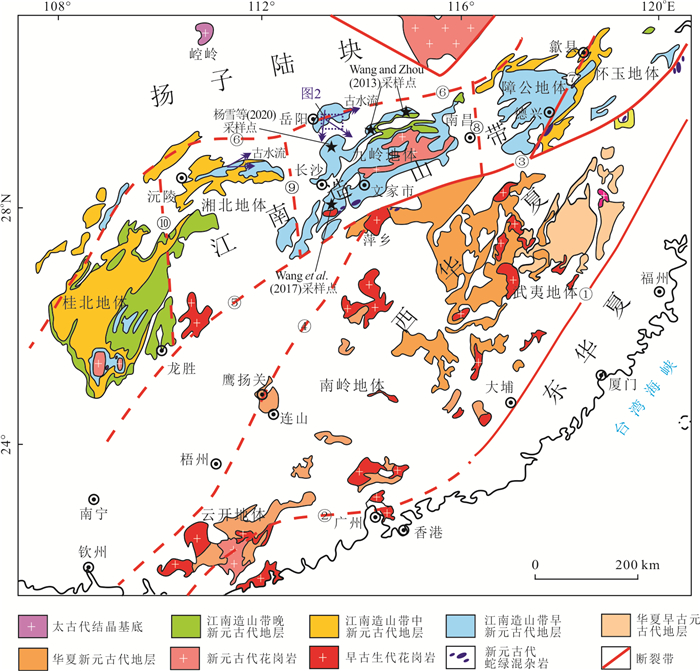
 下载:
下载:


